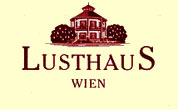|
In 1560, when Emperor Maximilian II. unified the fiefdom of some monasteries and municipalities in the greater area of today's Prater to be the private, imperial hunting ground, the so-called “Green Lusthaus”, a hunting lodge, was built.
In 1766, Emperor Josef II. opened up the Prater for the public, which was to that point only accessible to the court and the upper nobility. From 1781 to 1783, the Lusthaus was rebuilt by Isidore Canevale by order of Josef II.
Since then, the Lusthaus has repeatedly been the scene of huge events and festivities.
On October 18, 1814 – after the first anniversary of the battle of the nations close to Leipzig where Napoleon's power had been destroyed – a sumptuous army festivity on the occasion of the Vienna Convention was held at the Prater.
All the monarchs who gathered in Vienna for this very congress – like Tzar Alexander of Russia, the kings of Denmark, Prussia, Bavaria and Wuerttemberg, the elector of Hesse and many more - contributed to the festivities.
18,000 people – infantry and cavalier – were fed. The glamorous centre of the festival was the Lusthaus, where dinner was served for the Imperial family, the high sovereignty, the crown- and hereditary princes, the field marshal and minister of war earl Schwarzenberg.
At the table of archduke Carl on the first floor, the archdukes, the princes and other dignitaries were celebrating.
In the long epoch of Emperor Franz Josef I.'s rule the Freudenau was the centre of equine sports for nobility and bourgeoisie.
There, the annual derby, which was known as the main social event, as well as the flower pageant, took place, where the Lusthaus was meeting point and stage of Vienna's elegant and classy life and was frequently visited by the Emperor himself.
The racecourse Freudenau with its 2,800 metre long track is still known as the scenically most beautiful racecourse in Europe.
The main avenue was used to for the Fiaker (hackney carriage) races, whereas the famous Fiaker driver Haas – a frequent winner – was able to finish the race from Praterstern to the Lusthaus by Fiaker in 19 minutes, still a held record. 1903, the first car races took place on the Prater's main avenue.
World War I came along with business restrictions as well as with military billeting.
The Lusthaus was forced to accommodate the bridge guards, who were responsible for protecting the Danube bridge from sabotage.
The end of the war as well as the overthrow of the Austrian-Hungarian monarchy caused not only changes in the buildings architecture like the annex of a kitchen and side rooms, it also implicated a restructuring of guest and audience classes at the Lusthaus.
Since the interwar period was a tough time for everyone, people went to the Lusthaus to gain distraction: there was a bar with dance and music.
At the Freudenau, a polo field was laid out, which is today used as a golf course. In 1924, the pilgrimage church “Maria Green” was built, which was highly frequented during the interwar period.
Surrounding the memorial stone of the innkeeper Franz Plankenbüchler (killed in action), a place of worship in the riparian forest was built with hundreds of devotional pictures fastened to the trees.
Today, the church, that is romantically located on a clearing, is a famous and popular church for weddings – with the obligatory wedding feast afterwards in the nearby located Lusthaus.
On March 17, 1944 the first air attack was documented. On February 15, 1945 an American aircraft bomb hit the backside of the Lusthaus, which made the annex as well as the staircase collapse.
During the fights of the 6 th German Armoured Division against the Soviet Troops of the 20 th Guard Rifleman Brigade, the remains of the Lusthaus were again hit to the hardest.
The wooden shingled roof with the paned lantern was destroyed, columns and balconies collapsed, the inside was ravaged and plundered.
First, a reconstruction of the Lusthaus could not even be considered due to general distress after the war.
The destroyed Prater – separated from the city after the blasting of the Danube Canal bridge – and especially the racecourse were used as feeding ground for the occupying power's cattle.
In 1948, the long-desired reconstruction of the Lusthaus was able to be started according to the design concept of Prof. Dr. Michel Engelhart and under survey of the State Office for Historical Monuments of Austria.
On October 28 th , 1949 City councillor Richard Nathschläger handed the Lusthaus officially over to the public within a ceremonial act.
The Prater is always in flux, yet the Lusthaus is still a place for “everyone to use openly and freely”, just like Emperor Joseph intended.
If you are interested (and speak German), we highly recommend “Das Lusthaus im Wiener Prater” by Erich Zinsler, History of an almost forgotten Viennese landmark, supplement 4, 2000 Wien – which was the used source for the article above. |








